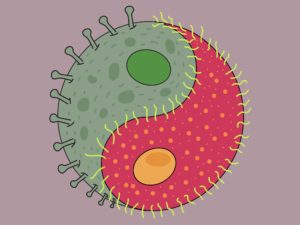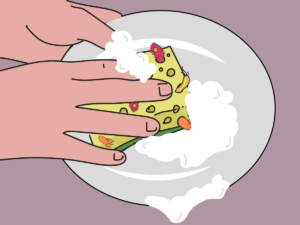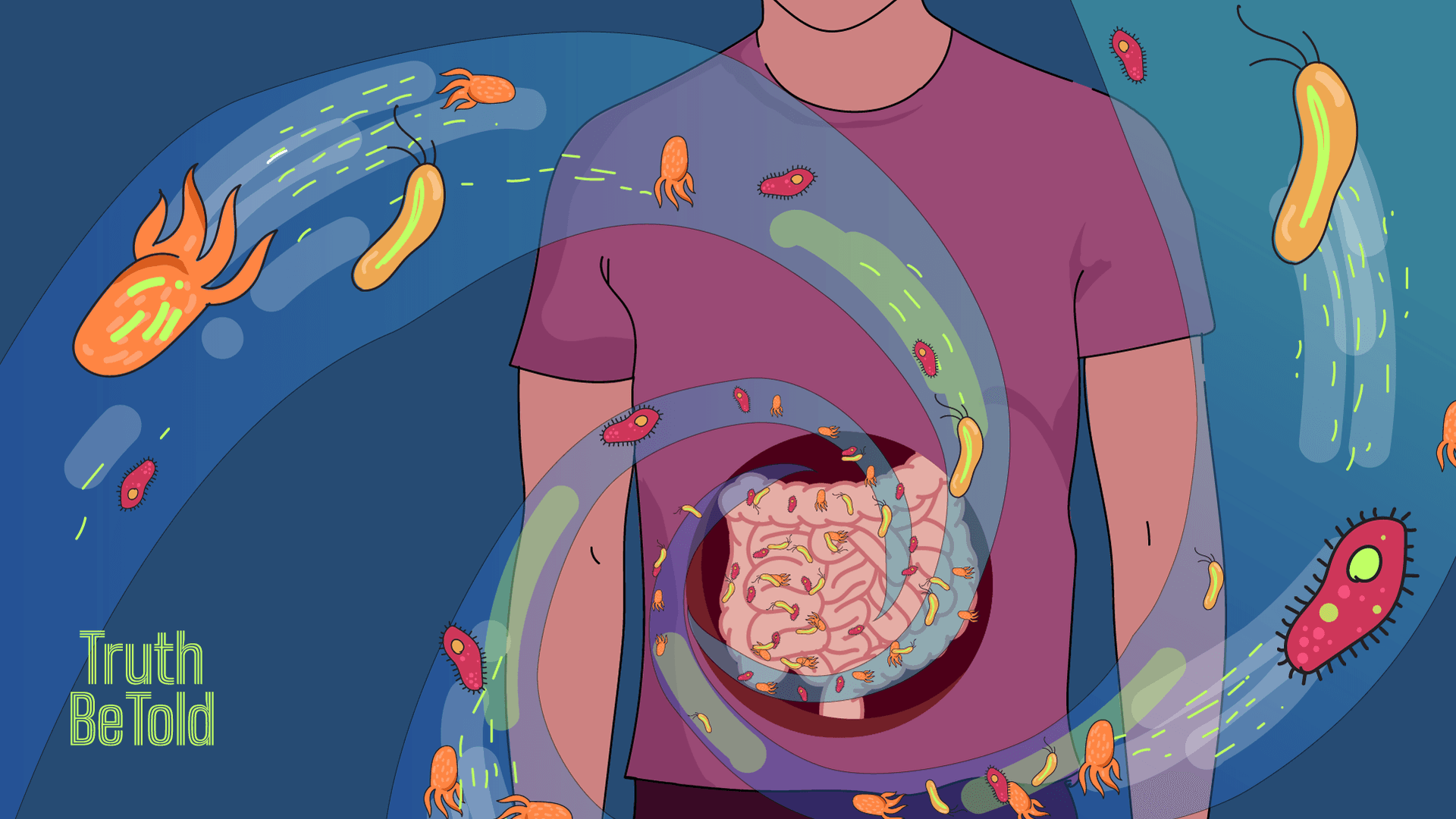How to improve gut health?
What is the gut? What are gut microbiomes? What is gut health? What can I do to improve gut health?
The most trustworthy source of food and
fitness journalism in the country.
Editor’s Note: Hi there, this is Samarth Bansal, the Editor of this newsletter and the writer of today’s article, where I introduce the fascinating world of gut microbes and some tips to cultivate a healthy relationship with them to promote a more wholesome life.
Trust your gut, they say. But which gut?
The ‘good’ gut that whispers sweet nothings of kale salads and green smoothies? Or the ‘bad’ gut that tempts you with sugary doughnuts and spicy samosas? What does ‘trusting the gut’ mean?
Biologically speaking, it means trusting a secretive, hidden world inside us, one that we don’t talk about often.
I’m not talking about our hidden talents and repressed emotions. I’m talking about the trillions of tiny things we are taught not to like, stay away from, think of as our enemy, and with absolutely no moral conflict, even kill them with pride in everyday life — bacteria, viruses, fungi, and other microbes.
These guys are so tiny we can’t see them with the naked eye, so we may not be aware that they have built a home inside us. Now they may be small, but they play big games. Some of them are like personal trainers, keeping us healthy and happy; others are more like that friend who always suggests getting a second slice of cake.
They matter. Just look at the scale at which they exist inside us.
We have 10 trillion human cells. But we have ten times more—100 trillion—bacterial cells that we host. And these bacteria collectively carry 100 times more genes of different kinds than all of the genes in the human genome.
So some say we are more bacteria than humans. (And as in everything in the world of nutrition, some say that new research says that’s a myth.)

They are found in various parts of our body, like the skin and mouth, but more than 90% exist in the human digestive tract, also called the gut, which includes the stomach, small intestine, and large intestine. The gut microbiome refers to the collection of microorganisms living in our gut.
I was unaware of this until I started diving into health literature. My biology teacher may have mentioned it during lectures, but my memory failed me.
Regardless, the point is this: the gut is not just a place where food gets churned and digested. It’s now getting the attention it deserves as the epicentre of our overall health. Emerging research shows these little critters affect our immune system, mood, and weight.
The starting point to understand this is to alter our intuitions about microbes: they can be good for us! The critical point is this: there are good bacteria and bad bacteria, and we want more of the former and less of the latter in our bodies.
Achieving this balance is called ‘gut health’. And an imbalance can lead to various health issues, such as digestive problems, inflammation, and even mental health issues.
I must start the discussion with a confession: every time I dive into the latest health craze, I feel overwhelmed and anxious about what else I need to do to stay healthy—because there will always be that new product that promises to solve that new problem from the latest science. This feeling resurfaced while researching this piece.
So let me get this straight: good gut health is not complicated. It starts with the standard stuff: eat well, exercise, sleep, and manage stress—all of which we covered in our first TBT piece. So don’t worry if you don’t have the latest kombucha, Greek yoghurt, or trendy probiotic supplement yet.
But understanding the gut offers a fresh perspective reinforcing the importance of the fundamental health principles we already know.
It also provides a unique insight into our interactions with the microbial world surrounding us, extending beyond eating habits to lifestyle habits, such as hygiene practices, cleanliness, and medications.
The complexity of these interactions is fascinating. Let’s dive in.
Start with the origin story: how did these tiny microorganisms get inside us? Who permitted them to enter us?
Answer: No one. They didn’t ask.
Just at the time after birth, the baby’s gut is a clean slate, free from any bacteria—the womb is a completely sterile environment.
But right after, microbes start colonising our body, and the gut microbiome develops rapidly. It begins during delivery as the baby passes through the birth canal, where it comes into contact with the mother’s microbes.
So the way the baby is delivered impacts the early microbiome. Babies born vaginally get a dose of beneficial bacteria from their mother’s vaginal and faecal microbiota. This infuses the gut with beneficial bacteria. But babies born by C-section are colonised by microbes from the surrounding environment, like the skin of healthcare workers and the hospital environment. How this affects long-term health in the two groups is not entirely understood yet.
As we grow from babies to toddlers, our curious nature makes us explore the world around us in unconventional ways. Eating solid food for the first time, crawling around on the floor, and even munching on a bit of mud from a flowerpot all introduce new bacteria into our developing gut microbiome.
As life goes on, the composition of the bacteria can change in response to various factors such as diet, medication use, and lifestyle. Still, compared to early childhood, it is more stable and resistant to change in adulthood.
All we want is for the gut to maintain a good balance: more good bacteria, less bad bacteria.
This bacterial balance matters.

Here is an example.
Picture this: you’re sitting on the couch, enjoying a relaxing evening, when suddenly, you crave something sweet. You know you shouldn’t indulge but you can’t shake off the feeling. Ever wonder why this happens? Well, it turns out that your gut microbiome might be the culprit.
When your gut microbiome is out of balance, meaning there’s too much bad bacteria and too little good bacteria, it can wreak havoc on your food cravings. Suddenly, that slice of cake looks like the most delicious thing in the world, and you can’t resist it.
But here’s the catch: sugary or processed foods only feed the bad bacteria, worsening the imbalance—we will have more bad bacteria and more sugar cravings. It’s a vicious cycle; before you know it, you’re stuck in a never-ending loop of cravings and unhealthy food choices.
On the flip side, having a healthy and diverse gut microbiome can be a game-changer. When your gut is in good shape, it sends positive signals to your brain, reducing your cravings for unhealthy foods and promoting feelings of well-being.
This is where the ‘gut-brain axis’ comes in. It’s the connection between your gut and your brain, and it plays a crucial role in determining what we crave and eat—among all other things.
The point is: it’s all about finding that balance.
Poor gut health could be the reason for your cravings
Subscribe to know more such interesting facts
But also remember that gut health is one of the many factors that influence our health.
As Giulia Enders writes in her fascinating book, ‘Gut: The Inside Story of Our Body’s Most Underrated Organ’:
“The important thing is not to reduce the human body to a two-dimensional cause-and-effect machine. The brain, the rest of the body, bacteria, and the elements in our food all interact with each other in four dimensions. Striving to understand all these axes is surely the best way to improve our knowledge. However, we can more easily tinker with bacteria than with our brain or our genes-and that is what makes microbes so fascinating.”
How to maintain the balance, promote good bacteria and eliminate harmful bacteria?
Few simple things first: get good sleep, control your sugar intake (including artificial sweeteners), control alcohol intake, manage your stress, and eat fibre-rich fermented foods like kimchi, sauerkraut, and yoghurt, which promote the growth of beneficial gut bacteria.
We will publish a dedicated guide soon on choosing the right dietary products for gut health so you can read beyond the marketing claims.
Today, I will talk about three things I learnt from Enders’ book, which go beyond what we eat to maintain a healthy gut.
One: Too much cleaning?
Enders offers a refreshing perspective on cleaning, cautioning against excessive hygiene and sterilisation. While it’s important to keep harmful bacteria at bay, it’s equally important to maintain a healthy balance of good bacteria in our environment.
Fear-driven hygiene can disrupt this balance, which involves trying to get rid of every last germ. The downside is that when we overdo it, we end up getting rid of the good bacteria along with the bad. This can have negative consequences for our gut health and may even contribute to the rise of allergies and autoimmune diseases.
She writes:
The higher the hygiene standards in a country, the higher that nation’s incidence of allergies and autoimmune diseases. The more sterile a household is, the more its members will suffer from allergies and autoimmune diseases.
Thirty years ago, about one person in ten had an allergy. Today that figure is one in three. At the same time, the number of infections has not fallen significantly. This is not smart hygiene.
So instead of using disinfectants for regular cleaning around the house, Enders recommends using water and a little cleaning fluid. This can reduce the number of bacteria on surfaces by 90% while still leaving behind the good bacteria that help keep things balanced.
Using a kitchen sponge is one of the most compelling examples of how we can inadvertently be doing more harm than good while attempting to clean. We may spread harmful bacteria without realising it when we wipe down our plates, cutlery, and cutting board with a sponge.
According to Enders, kitchen sponges are a haven for microbes, providing a warm, moist environment and a ready food source. When you use a wet sponge to clean your dishes and then store them away without thoroughly rinsing them, you transfer bacteria from the sponge onto your utensils.

The growth of harmful bacteria can cause illness, so it’s essential to be aware of this issue and take steps to prevent it. For example, you should only use kitchen sponges to clean up the worst dirt, and make sure to rinse plates, cutlery, and cutting boards thoroughly under running water.
Additionally, dish towels or drying-up cloths should be allowed to dry out completely to avoid the growth of bacteria. Sponges and cloths should be wrung out and left to dry properly since moisture can create an ideal breeding ground for harmful bacteria.
Like what you see so far?
Subscribe to get more interesting reads in your inbox every Saturday
Two: Use antibiotics responsibly
Have you ever taken antibiotics for a cold? If so, you’re not alone: many people mistakenly believe that antibiotics can cure viral infections like the common cold. But as Enders points out, this is a total waste of time. Antibiotics are powerful tools for fighting bacterial infections, but they don’t do anything against viruses.
Overuse and misuse of antibiotics can be a severe problem. When we take antibiotics unnecessarily, we not only kill off harmful bacteria, but also helpful ones that make up our microbiome. Unfortunately, this can lead to a less diverse microbiome and even changes in the abilities of the bacteria it contains.
As Enders writes:
“Our relationship with antibiotics is an arms race.” The more we use antibiotics, the more resistant bacteria become. It’s a trade-off: we sacrifice our good bacteria in the hope of getting rid of the bad. For serious illnesses, this can be a good deal, but for minor colds, it’s not worth it.”
So next time you feel under the weather, remember that antibiotics are not always a cure-all. Use them responsibly.

Three: Watch out for the eggshells and raw meat
Salmonella is a common type of bad bacteria that can cause human foodborne illness. It can be found in various foods, including poultry, meat, and unpasteurised milk.
One common source of Salmonella contamination is eggshells, undercooked eggs, or raw meat. The bad bacteria can be present on the surface of the eggshells and can easily contaminate other foods or surfaces they come into contact with.

To prevent bacterial contamination in the kitchen, Enders recommends using plastic chopping boards as they are easier to clean and have fewer spaces for bacteria to hide than other materials.
Also, she says to ensure that surfaces or utensils that come into contact with raw meat or eggshells are thoroughly washed with hot water, including hands, cutting boards, cutlery, and kitchen sponges. And thoroughly cook meat and egg-based dishes to minimise the risk of foodborne illness.
That’s all for today. I hope this gives you a broad intuition about what gut health is. More soon in our consumer guide, where we will dive into probiotics and prebiotics. Stay subscribed to Truth Be Told, so you don’t miss that one.

